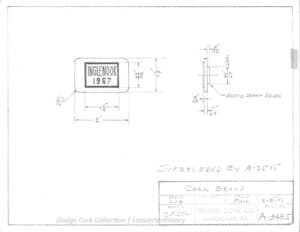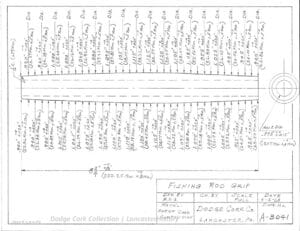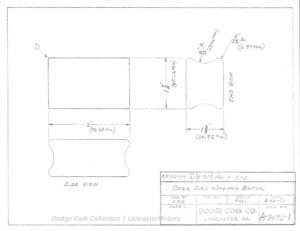Lancaster’s Cork Connection | Part 3
From Portugal to Lancaster and Around the World with Dodge Cork
Written by James McMahon, Ph.D.
Posted by Emily Miller
My name is James McMahon and for the past few months I have been working as a project archivist for LancasterHistory. My responsibilities include cataloging and digitizing a vast collection of archival materials that document the significant role of the cork industry in the local economy.
Part I of this blog explored where cork comes from, how cork is used, and efforts to grow cork oak trees locally and around the country. Part II took a look at the beginnings of the cork industry in Lancaster and highlighted a few images of interest from the LancasterHistory collection related to the history of the Armstrong Cork Company. Part III is a chance for me to highlight a few more images from the LancasterHistory collection; images associated with the longstanding role played by the Dodge family and various cork companies associated with their name here in Lancaster.

The first cork company in Lancaster to bear the Dodge name was G.W. Dodge & Son. Founded in 1871 in Berlin, New York by George W. Dodge, the company relocated to Lancaster in 1876. Cutting corks by hand, Dodge imported corks to be used in casks, jugs, and bottles. According to an interview with Arthur B. Dodge III in 2012, G.W. Dodge started in business for himself after securing a large account for cork stoppers from the Gulden Mustard Company. In this same interview, Dodge also noted that G.W. Dodge had a number of important business connections, including a relationship with Henry Heinz, founder of the H.T. Heinz Co., of Pittsburgh.
In 1885, Byron G. Dodge, eldest son of George W. Dodge, took over his father’s role in the company. In 1895, B.G. Dodge, now president of the Lancaster Cork Company; Thomas M. Armstrong, founder of Armstrong, Brother & Company; and other smaller concerns in Lancaster agreed to come under the Armstrong corporate umbrella as the Armstrong Cork Company. The new company operated out of what was then the Lancaster Cork Company facility along New Holland Avenue, but would soon become the Lancaster Closure Plant of Armstrong Cork Company. B.G. Dodge and his son, Arthur B. Dodge, successively managed the Closure Plant until 1926, when Arthur B. Dodge resigned his position to establish the Dodge Cork Company.

Arthur B. Dodge, grandson of G. W. Dodge who first introduced the Dodge name to the cork industry, served as president of the Dodge Cork Company for thirty years until his retirement in 1956. Under Arthur Dodge’s leadership, the company pioneered the production of composite cork used in the manufacture of gaskets, bulletin boards, wall coverings, and cork floor tiles; rubber cork, a material used in sealing, friction applications, and textile roll coverings; and vinyl coated cork floor tile. During the 1950s, Arthur B. Dodge’s sons Richard K. Dodge and Arthur B. Dodge, Jr., became increasingly involved in the family business. According to the Dodge Cork website, the Dodge Cork company produced one million square feet of cork floor tiles per month by 1962. By the 1970s, the company was also making recycled rubber and cork materials for industrial markets.
A sixth generation family business, Dodge Cork continues to be family owned and to operate out of the Lancaster area. The company proudly traces its history back to G.W. Dodge and the founding of G.W. Dodge & Son in 1871. While the company continues to manufacture and distribute a wide variety of cork products for commercial and household use, the cork stopper or closure has been—and continues to be—a major focus of the company’s production. These three technical drawings from the 1970s illustrate stopper designs designed and produced by Dodge Cork for two national wineries and a generic stopper decorated with stipples and knurls; a stipple being a pattern of small dark spots or specks on a surface and a knurl being a projecting ridge around the edge of a surface. In this case, the knurl served as a grip to aid in the removal of a stopper.
Reader Tip: Click drawings to enlarge photographs.
The Dodge Cork Company technical drawings housed at LancasterHistory also contain a few examples of sporting goods and sporting goods accessories that were once commonly made out of cork. Examples below include a fishing rod grip, a table tennis handle, and even a snow ski waxing block. Apparent in all the drawings is the high degree of accuracy, attention to detail, and exacting specifications required by these seemingly simple everyday items.
Reader Tip: Click drawings to enlarge photographs.
Today, Dodge Cork manufactures and distributes cork products for use in a variety of commercial and household applications, including spheres or balls, ideal for home décor, floats, or craft activities; rolls or sheets for use as bulletin boards or wall coverings; ring supports for holding various sizes of bottles and flasks, primarily in laboratories; and of course, stoppers.

According to the company website, Dodge Cork remains dedicated to the handcrafted manufacture of cork products in a sustainable and environmentally friendly manner and to introduce a new generation to the commercial and environmental benefits for both people and the planet of using natural cork rather than environmentally harmful synthetic substitutes.

Cork is one of the most versatile, naturally occurring, renewable resources on the planet. Despite its natural properties that make it impermeable, buoyant, elastic, and fire retardant, most consumers still think of cork as a bottle stopper; something used by manufacturers to keep liquids, particularly wine or champagne, from spilling and casually discarded after use.
Despite the seemingly ephemeral nature of the cork bottle stopper, companies that produce them take great pride in their work. As such, manufacturers routinely mark their cork stoppers with their name or a maker’s mark. Next time you open a bottle of your favorite adult beverage take a closer look at the stopper before you discard it. If your “cork” is marked with a symbol or logo, take a moment to visit the website “Cork and Logo” to see if you can identify the manufacturer. In this example, the mark on the champagne cork appears to be a mirror image of the letter “R” placed back-to-back. By visiting the Cork and Logo website, the mark can be easily identified as a Relvas Portuguese champagne cork. As always, enjoy responsibly!
If you would like to read the previous entries, here are some helpful links:
From Archives Blog





